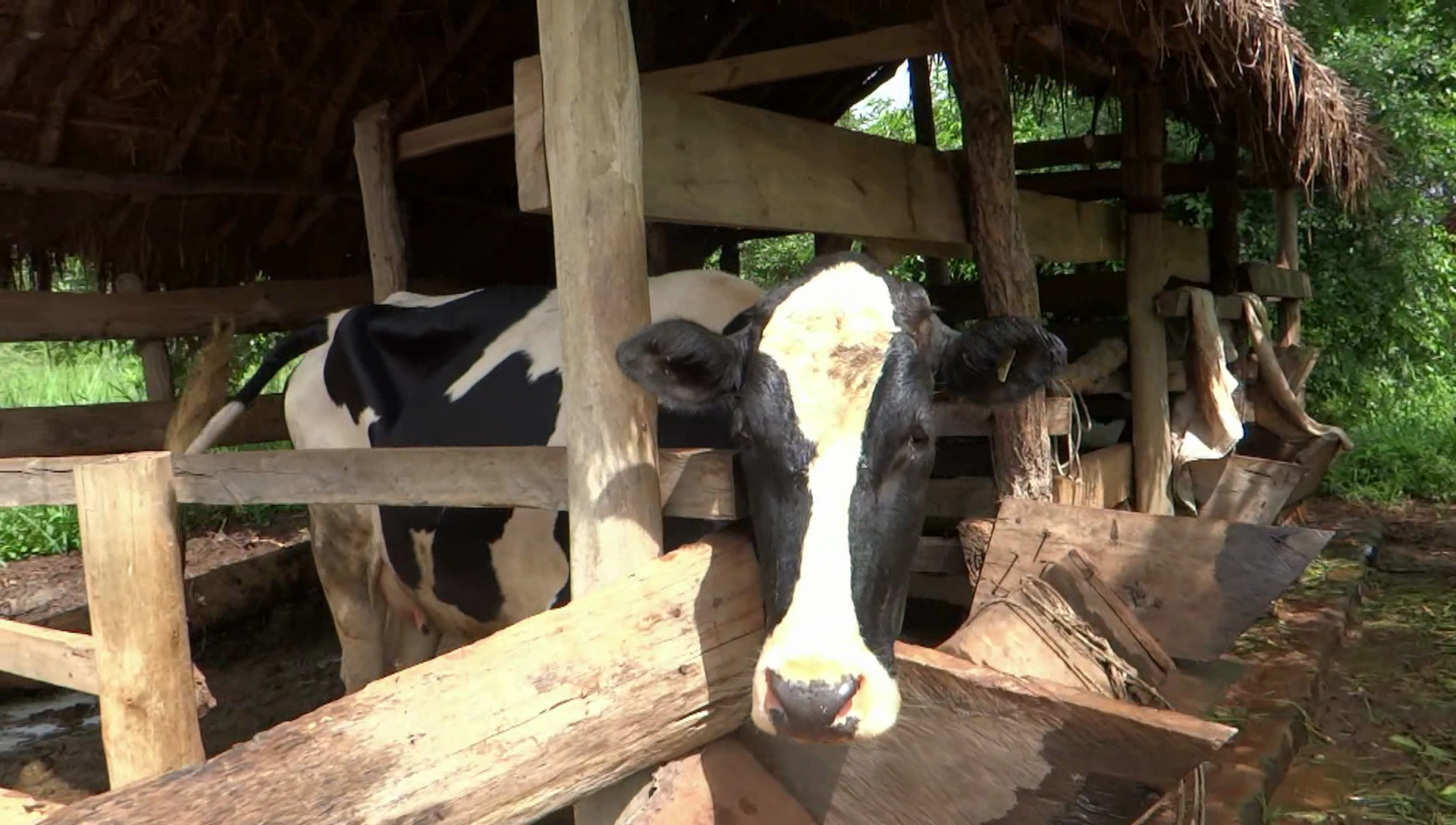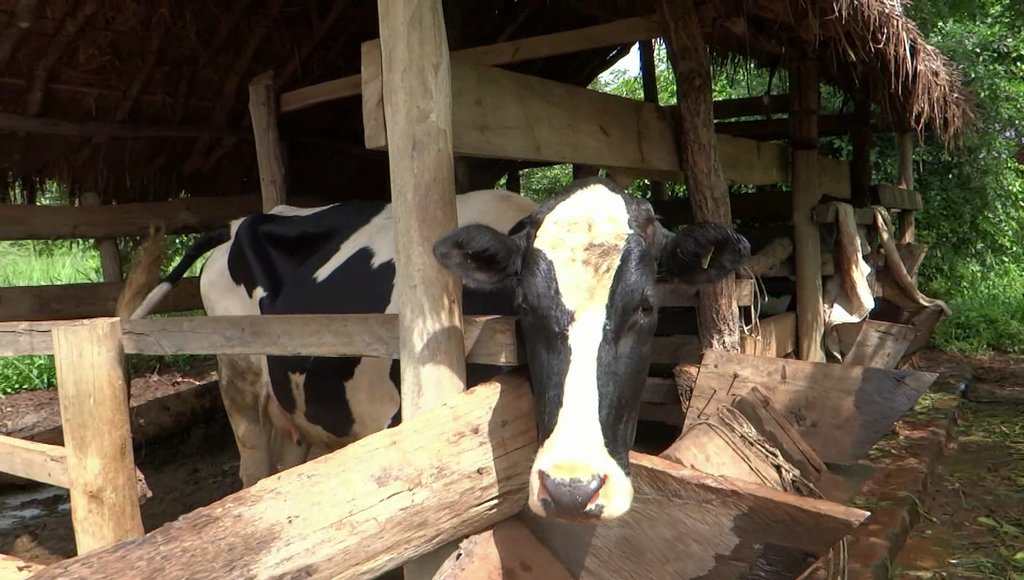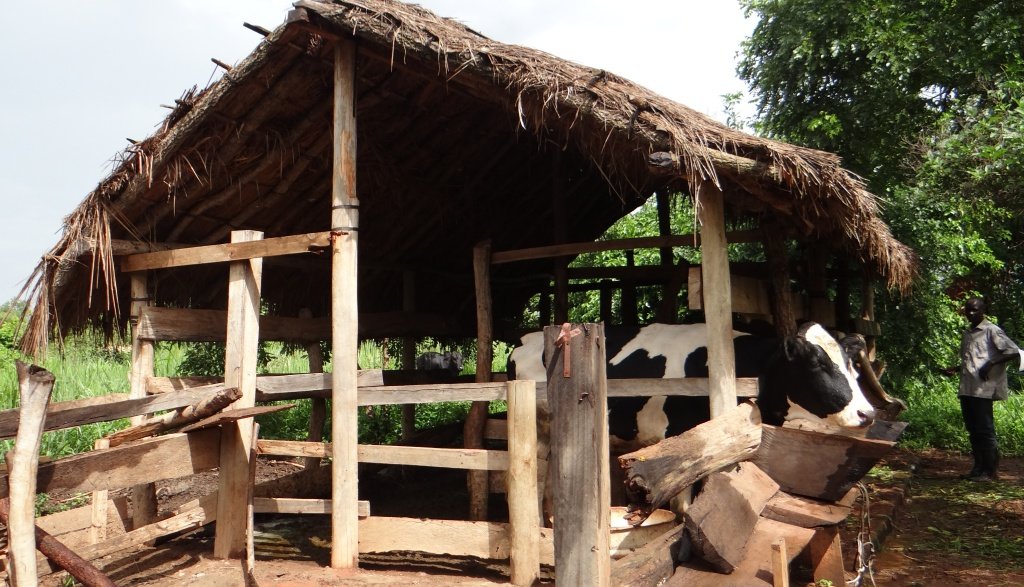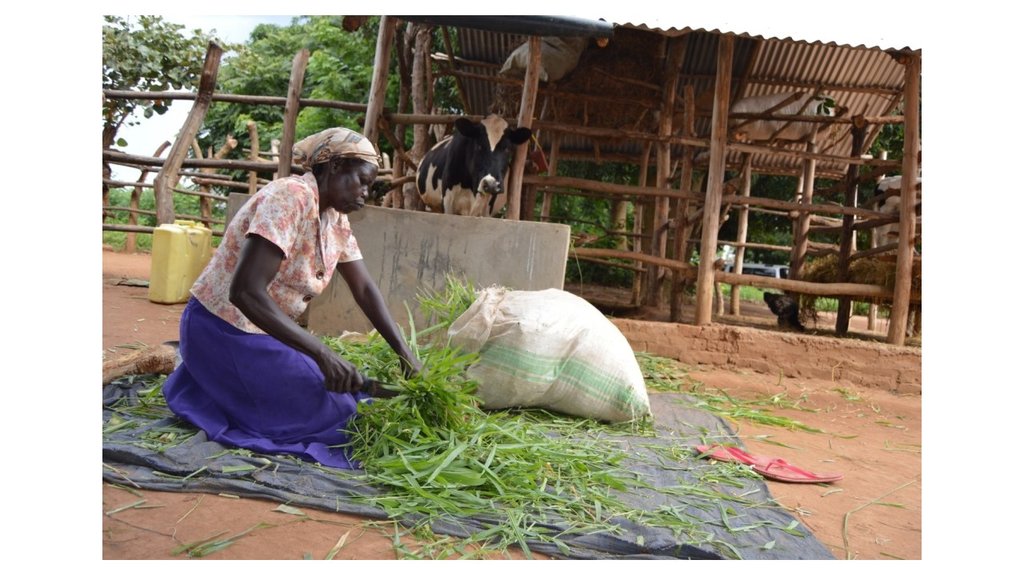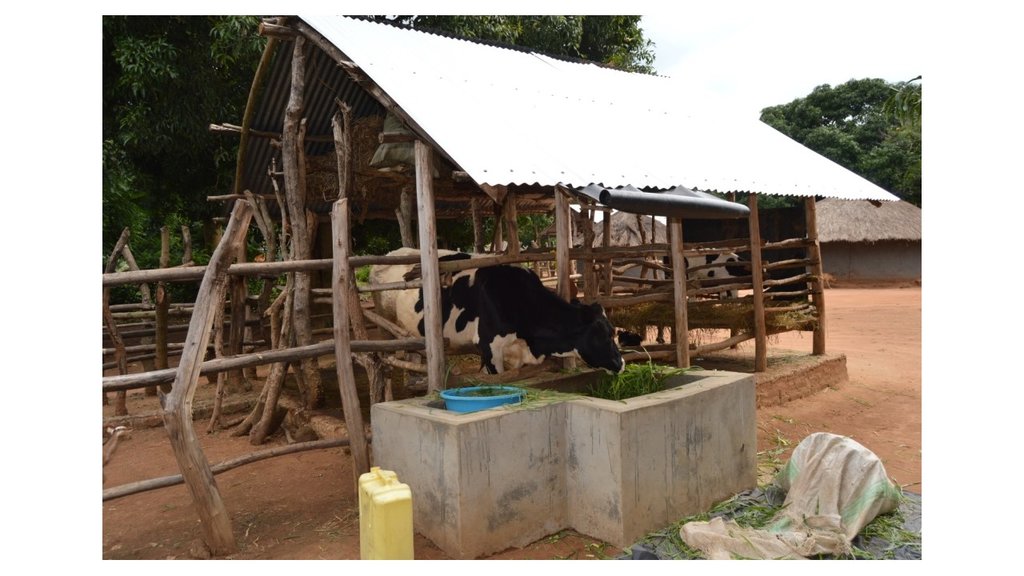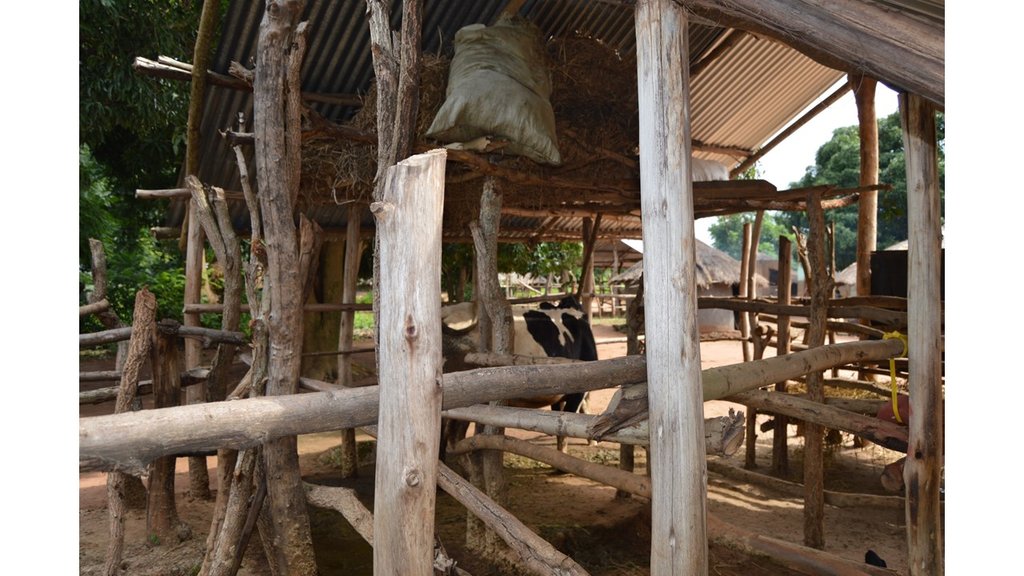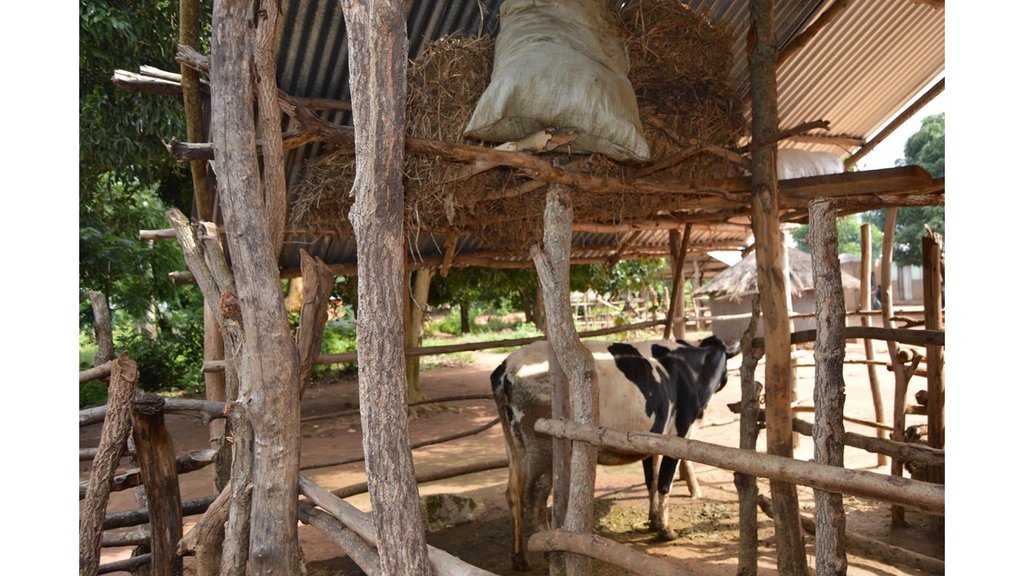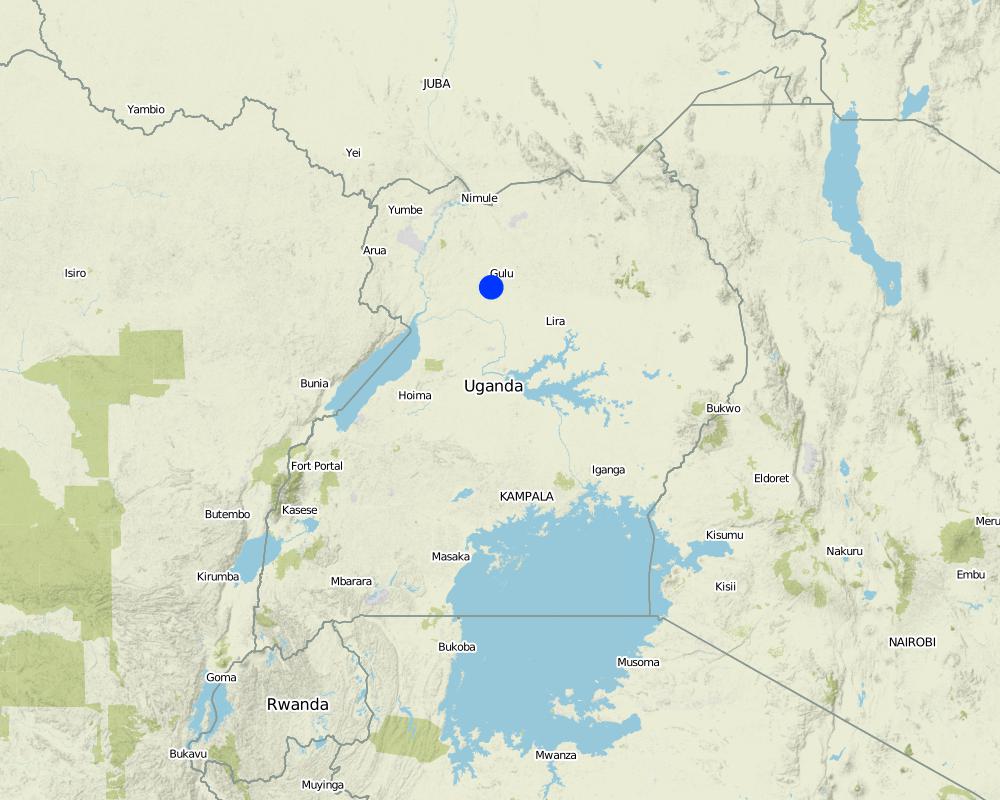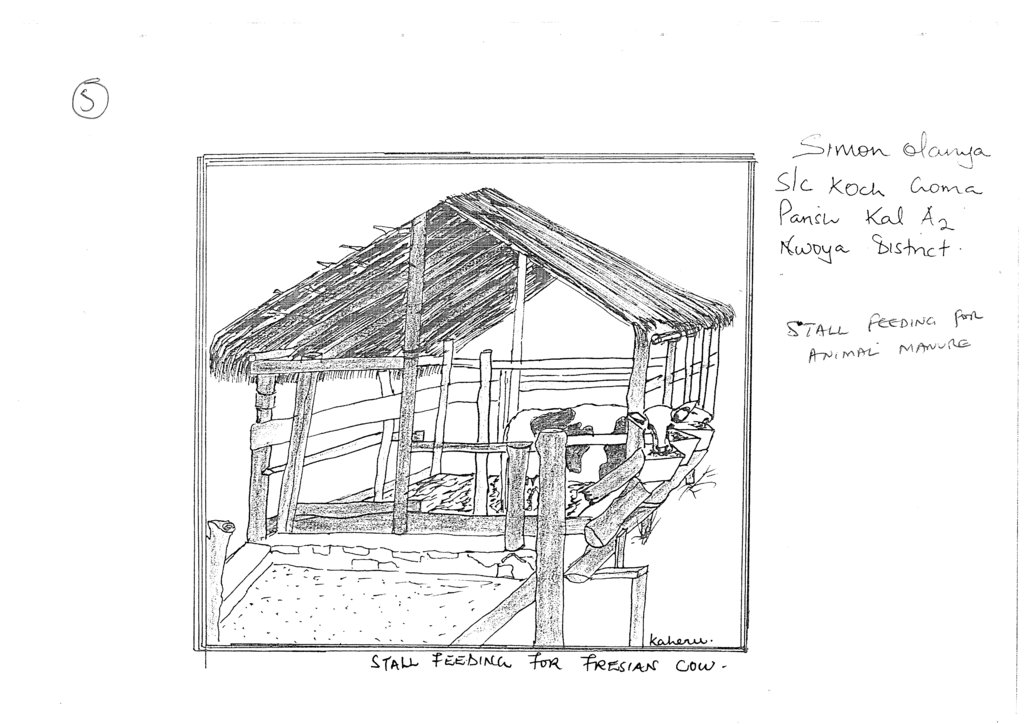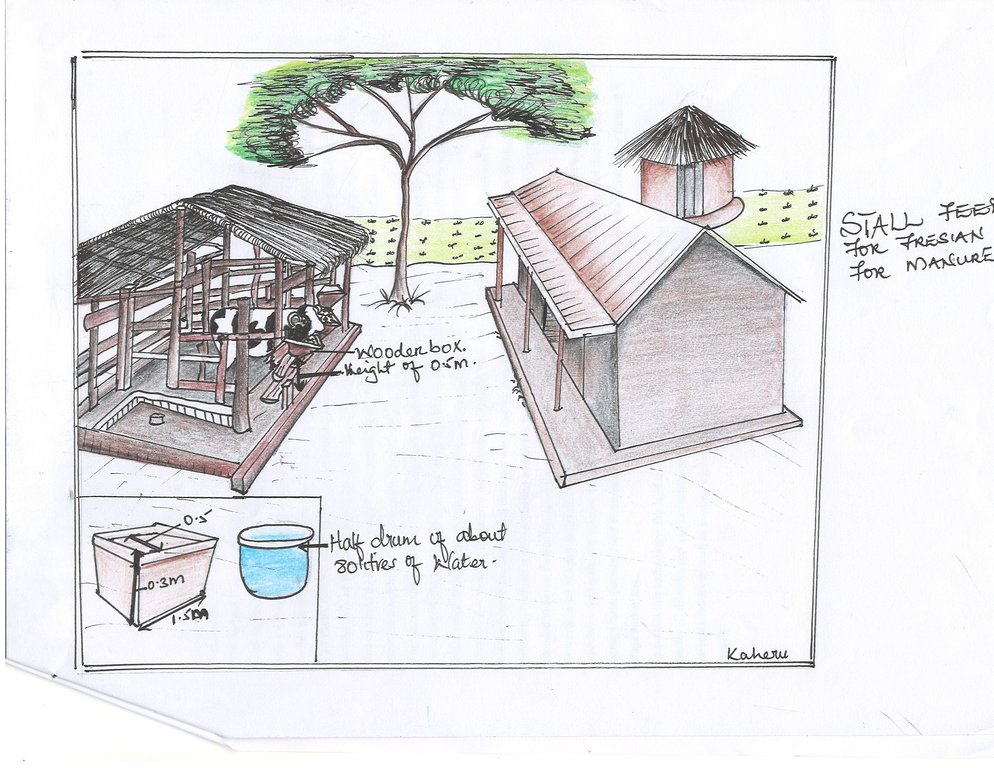Stall feeding of Friesian cow by cut and carry for livestock management [ยูกันดา]
- ผู้สร้างสรรค์:
- การอัพเดท:
- ผู้รวบรวม: Kamugisha Rick Nelson
- ผู้เรียบเรียง: Bernard Fungo, Richard Otto Kawawa, Sunday Balla Amale, JOY TUKAHIRWA
- ผู้ตรวจสอบ: Rima Mekdaschi Studer, Stephanie Jaquet, Renate Fleiner, Nicole Harari, John Stephen Tenywa, Donia Mühlematter, Alexandra Gavilano
Gokwo dyang
technologies_2816 - ยูกันดา
- บทสรุปทั้งหมดในรูปแบบของ PDF
- บทสรุปทั้งหมดในรูปแบบของ PDF เพื่อพิมพ์
- บทสรุปทั้งหมดในรูปหน้าเว็บ
- บทสรุปทั้งหมด (ไม่มีการจัดเรียง)
- Stall feeding of Friesian cow by cut and carry for livestock management: 16 กรกฎาคม 2018 (inactive)
- Stall feeding of Friesian cow by cut and carry for livestock management: 22 มีนาคม 2019 (inactive)
- Stall feeding of Friesian cow by cut and carry for livestock management: 22 สิงหาคม 2019 (public)
- Stall feeding of Friesian cow by cut and carry for livestock management: 14 มิถุนายน 2018 (inactive)
- Stall feeding of Friesian cow for manure: 22 พฤษภาคม 2018 (inactive)
ดูส่วนย่อย
ขยายทั้งหมด ย่อทั้งหมด1. ข้อมูลทั่วไป
1.2 รายละเอียดที่ติดต่อได้ของผู้รวบรวมและองค์กรที่เกี่ยวข้องในการประเมินและการจัดเตรียมทำเอกสารของเทคโนโลยี
วิทยากรหลัก
ผู้ใช้ที่ดิน:
Olanya Simon
Farmer
ยูกันดา
ยูกันดา
ชื่อของโครงการซึ่งอำนวยความสะดวกในการทำเอกสารหรือการประเมินเทคโนโลยี (ถ้าเกี่ยวข้อง)
Scaling-up SLM practices by smallholder farmers (IFAD)ชื่อขององค์กรซึ่งอำนวยความสะดวกในการทำเอกสารหรือการประเมินเทคโนโลยี (ถ้าเกี่ยวข้อง)
CDE Centre for Development and Environment (CDE Centre for Development and Environment) - สวิตเซอร์แลนด์1.3 เงื่อนไขการใช้ข้อมูลที่ได้บันทึกผ่านทาง WOCAT
ผู้รวบรวมและวิทยากรหลักยอมรับเงื่อนไขเกี่ยวกับการใช้ข้อมูลที่ถูกบันทึกผ่านทาง WOCAT:
ใช่
1.4 การเปิดเผยเรื่องความยั่งยืนของเทคโนโลยีที่ได้อธิบายไว้
เทคโนโลยีที่ได้อธิบายไว้นี้เป็นปัญหาของความเสื่อมโทรมโทรมของที่ดินหรือไม่ จึงไม่ได้รับการยอมรับว่าเป็นเทคโนโลยีเพื่อการจัดการที่ดินอย่างยั่งยืน:
ไม่ใช่
2. การอธิบายลักษณะของเทคโนโลยี SLM
2.1 การอธิบายแบบสั้น ๆ ของเทคโนโลยี
คำจำกัดความของเทคโนโลยี:
Zero grazing by cut and carry feeding. The cows do not graze but are confined inside the stall, feed and water is provided for the animals.
2.2 การอธิบายแบบละเอียดของเทคโนโลยี
คำอธิบาย:
Due to land fragmentation and conflicts, traditional grazing systems where animals are reared in open grasslands is no longer feasible and sustainable since grassland is limited and stray animals would destroy neighboring crops. Now small holders with limited land but diversified livelihoods have to utilize the available land in full capacity and sustainable ways. For dairy farmers, stall feeding is an innovative and promising system.
In this practice, a Friesian cow and its calf are confined inside the built stall. The stall has four partitions. A Calf room, milking pallor, feeding and drinking area and sleeping room. Within the feeding area is placed a wooden box of width 0.5m, length 1.5m and height 0.3m; into which feed is put for the animal. A half drum that can hold 80 liters of water is also put inside the feeding area. Both the wooden feeder and half drum are raised to a height of 0.5 m above the ground surface to prevent contamination of the feed with dung and urine; and also ensure efficient feed intake.
The farmer cultivated 1 acre of Napier grass (elephant grass), which provides adequate feed for the demands of the cow (75-100 kg of fresh grass per day). The Napier grass is cut, chopped and put inside the wooden box, while water is fetched from the stream and put into the half drum.
Through this method, the animal movement is restricted. This reduces the exposure to parasites such as ticks, and contagious diseases such as East Coast Fever. This practice also reduces land conflicts that would be caused by stray animals destroying crops of neighbors. The animal does not waste energy to look for pasture and water, hence milk productivity is enhanced. Manure is also deposited within the feeding area and thus easy to collect, decompose and apply in both farmers’ crop and pasture fields. Animals do not need to be attended to, hence farmer has more time to rest and carry out other activities.
However, a lot of labor is required for cutting and chopping the grass, and carrying the feeds and water especially during the dry season. Treatment of animals and maintenance of the stall is costly and if management is poor, parasites and diseases can also build up within the stall. Stall feeding requires feed preservation in the form of fermented pasture (silage) and/or dried pasture (hay); stored and to be used for feeding the animals during dry seasons when pasture is dry and of poor quality.
To sustain this technology, the land users can supplement the feed through cultivating multipurpose tree species (Calliandra spp and Grivellia spp), leguminous forages such as lablab spp and macuna beans. Non-conventional feeds such as kitchen wastes (cassava, sweet potato and banana peelings) can also supplement the cut and carried Napier grass.
2.3 รูปภาพของเทคโนโลยี
2.4 วีดีโอของเทคโนโลยี
ความคิดเห็น/อธิบายสั้นๆ:
Video showing Stall feeding for fresian cow for animal manure
วันที่:
26/05/2017
สถานที่:
Kosh village , Goma parish Unyona sub-county , Nwoya District
ชื่อผู้ถ่ายวีดีโอ:
Issa Aiga
2.5 ประเทศภูมิภาค หรือสถานที่ตั้งที่เทคโนโลยีได้นำไปใช้และได้รับการครอบคลุมโดยการประเมินนี้
ประเทศ:
ยูกันดา
ภูมิภาค/รัฐ/จังหวัด:
Northern Region,Uganda
ระบุการกระจายตัวของเทคโนโลยี:
- กระจายไปอย่างสม่ำเสมอในพื้นที่
If precise area is not known, indicate approximate area covered:
- < 0.1 ตร.กม.(10 เฮกตาร์)
แสดงความคิดเห็น:
Map showing the technology site in Northern Uganda
Barn, area where napier grass is planted, cut and carried.
Map
×2.6 วันที่การดำเนินการ
ระบุปีที่ใช้:
2014
ถ้าไม่รู้ปีที่แน่นอน ให้ระบุวันที่โดยประมาณ:
- น้อยกว่า 10 ปี (ไม่นานนี้)
2.7 คำแนะนำของเทคโนโลยี
ให้ระบุว่าเทคโนโลยีถูกแนะนำเข้ามาอย่างไร:
- ทางโครงการหรือจากภายนอก
3. การจัดประเภทของเทคโนโลยี SLM
3.1 วัตถุประสงค์หลักของเทคโนโลยี
- สร้างผลกระทบทางด้านเศรษฐกิจที่เป็นประโยชน์
- สร้างผลกระทบทางด้านสังคมที่เป็นประโยชน์
3.2 ประเภทของการใช้ที่ดินในปัจจุบันที่ได้นำเทคโนโลยีไปใช้

พื้นที่ปลูกพืช
- การปลูกพืชล้มลุกอายุปีเดียว
- การปลูกไม้ยืนต้น ไม้พุ่ม
- lablab spp and macuna bean
- Calliandra spp and Grivellia spp
จำนวนของฤดูเพาะปลูกต่อปี:
- 2

ทุ่งหญ้าเลี้ยงสัตว์
ทุ่งหญ้าเลี้ยงสัตว์ที่มีการจัดการแบบเข้มข้นหรือการผลิตอาหารสัตว์:
- ตัดแล้วขนไป / ไม่มีการปล่อยแทะเล็มเอง (Cut-and-carry / zero grazing)
Animal type:
- cattle - dairy
- cow =1 . calf =1
- Fresian cow, milk production, manure and calf.
3.3 Has land use changed due to the implementation of the Technology?

พื้นที่ปลูกพืช
3.4 การใช้น้ำ
การใช้น้ำของที่ดินที่มีการใช้เทคโนโลยีอยู่:
- จากน้ำฝน
แสดงความคิดเห็น:
Use tap water from neighbour(brother) who pump under ground using generator.
Number of growing seasons per year:
2
3.5 กลุ่ม SLM ที่ตรงกับเทคโนโลยีนี้
- การจัดการปลูกพืชร่วมกับปศุสัตว์
- การจัดการความอุดมสมบรูณ์ของดินแบบผสมผสาน
- Stall feeding
3.6 มาตรการ SLM ที่ประกอบกันเป็นเทคโนโลยี

มาตรการจัดการพืช
- A2: อินทรียวัตถุในดิน/ความอุดมสมบูรณ์ในดิน

มาตรการอนุรักษ์ด้วยการจัดการ
- M1: การเปลี่ยนรูปแบบของการใช้ประโยชน์ที่ดิน
- M2: การเปลี่ยนแปลงของการจัดการหรือระดับความเข้มข้น

มาตรการอื่น ๆ
แสดงความคิดเห็น:
Cut and carry
3.7 รูปแบบหลักของการเสื่อมโทรมของที่ดินที่ได้รับการแก้ไขโดยเทคโนโลยี

การเสื่อมโทรมของดินทางด้านเคมี
- Cn (Fertility decline): ความอุดมสมบูรณ์และปริมาณอินทรียวัตถุในดินถูกทำให้ลดลงไป (ไม่ได้เกิดจากสาเหตุการกัดกร่อน)

การเสื่อมโทรมของดินทางด้านกายภาพ
- Pc (Compaction): การอัดแน่น
- Pu (Loss of bio-productive function): การสูญเสียหน้าที่การผลิตทางชีวภาพอันเนื่องมาจากกิจกรรม อื่นๆ
3.8 การป้องกัน การลดลง หรือการฟื้นฟูความเสื่อมโทรมของที่ดิน
ระบุเป้าหมายของเทคโนโลยีกับความเสื่อมโทรมของที่ดิน:
- ลดความเสื่อมโทรมของดิน
4. ข้อมูลจำเพาะด้านเทคนิค กิจกรรมการนำไปปฏิบัติใช้ ปัจจัยนำเข้า และค่าใช้จ่าย
4.1 แบบแปลนทางเทคนิคของเทคโนโลยี
ข้อมูลจำเพาะด้านเทคนิค (แบบแปลนทางเทคนิคของเทคโนโลยี):
The stall should be 3 m tall, approximately with 4 rooms 1st floor for calf, second one for milking 3rd for sleeping and the 4th for feeding and drinking water.
The Inputs required for this technology include: concrete wall built with cement, , wood (makonko), grass or iron roof, wooden box of about 1.5x0.5 m, half drum of about 80 litres both raised at 50cm above the floor, rake , tauplin and polythene paper.
Slope: Gentle slope.
ผู้เขียน:
Kaheru
วันที่:
26/05/2017
4.2 ข้อมูลทั่วไปเกี่ยวกับการคำนวณปัจจัยนำเข้าและค่าใช้จ่าย
ให้ระบุว่าค่าใช้จ่ายและปัจจัยนำเข้าได้รับการคำนวณอย่างไร:
- ต่อพื้นที่ที่ใช้เทคโนโลยี
ระบุขนาดและหน่วยพื้นที่:
1.5 acres
อื่นๆ หรือสกุลเงินประจำชาติ (ระบุ):
UGX
If relevant, indicate exchange rate from USD to local currency (e.g. 1 USD = 79.9 Brazilian Real): 1 USD =:
3803.0
ระบุค่าเฉลี่ยของค่าจ้างในการจ้างแรงงานต่อวัน:
5000
4.3 กิจกรรมเพื่อการจัดตั้ง
| กิจกรรม | Timing (season) | |
|---|---|---|
| 1. | looking for land where to plant pasture | During the first rainy season |
| 2. | Looking for labour to clear the land, planting | Once in a year(April-June) |
| 3. | Looking for seed | once before establsihment |
| 4. | Planting the pasture | Daily after establishment |
| 5. | Initial construction of the stall | Once before establishment |
| 6. | Initial construction of of feeding and drinking troughs | Once before establishment |
| 7. | Putting the cow/s in the stall | Once after establishment |
| 8. | Feeding and watering | Daily |
4.4 ค่าใช้จ่ายของปัจจัยนำเข้าที่จำเป็นสำหรับการจัดตั้ง
| ปัจจัยนำเข้า | หน่วย | ปริมาณ | ค่าใช้จ่ายต่อหน่วย | ค่าใช้จ่ายทั้งหมดต่อปัจจัยนำเข้า | %ของค่าใช้จ่ายที่ก่อให้เกิดขึ้นโดยผู้ใช้ที่ดิน | |
|---|---|---|---|---|---|---|
| แรงงาน | labour for transporting wood and cement | Persons | 25.0 | 5000.0 | 125000.0 | 70.0 |
| แรงงาน | Labour for preparing and planting fields | Persons | 45.0 | 5000.0 | 225000.0 | 30.0 |
| แรงงาน | Labour for constructing stall | persons | 12.0 | |||
| อุปกรณ์ | Hoe | Pieces | 2.0 | 10000.0 | 20000.0 | 100.0 |
| อุปกรณ์ | Panga | Pieces | 1.0 | 7000.0 | 7000.0 | 100.0 |
| อุปกรณ์ | Spranger | Pieces | 1.0 | 10000.0 | 10000.0 | 100.0 |
| วัสดุด้านพืช | Elephant grass | bundles | 5.0 | 100000.0 | 500000.0 | 100.0 |
| วัสดุด้านพืช | lab lab | Pieces | 4.0 | 5000.0 | 20000.0 | 100.0 |
| วัสดุด้านพืช | Mucuna | Pieces | 1.0 | 20000.0 | 20000.0 | 100.0 |
| วัสดุสำหรับก่อสร้าง | Timber | Pieces | 40.0 | 3000.0 | 120000.0 | 100.0 |
| วัสดุสำหรับก่อสร้าง | Cement | bags | 10.0 | 30000.0 | 300000.0 | 100.0 |
| วัสดุสำหรับก่อสร้าง | Logs | Pieces | 60.0 | 3000.0 | 180000.0 | 100.0 |
| วัสดุสำหรับก่อสร้าง | Nails | kgs | 10.0 | 3500.0 | 35000.0 | 100.0 |
| อื่น ๆ | Grass to thatch the stall | bundles | 24.0 | 2000.0 | 48000.0 | 100.0 |
| ค่าใช้จ่ายทั้งหมดของการจัดตั้งเทคโนโลยี | 1610000.0 | |||||
| Total costs for establishment of the Technology in USD | 423.35 | |||||
แสดงความคิดเห็น:
Some seed like Macuna and brucheria was provided for free
4.5 การบำรุงรักษาสภาพหรือกิจกรรมที่เกิดขึ้นเป็นประจำ
| กิจกรรม | ช่วงระยะเวลา/ความถี่ | |
|---|---|---|
| 1. | Weeding pasture | Three times per year |
| 2. | Repairing of stall | once after establishment and when need |
| 3. | Treatment of cow | When need arises(sick) |
| 4. | Insemination | Once in two years |
| 5. | Spraying | Twice per week |
| 6. | Reseeding | During the rainy season |
| 7. | Replanting of pasture | During the rainy season |
| 8. | Cutting and carrying the grass to the animal | Daily after establishment |
| 9. | Collection of manure | Daily |
| 10. | Applying manure to the garden | Daily |
| 11. | Making silage and hay | During the wet season |
4.6 ค่าใช้จ่ายของปัจจัยนำเข้าและกิจกรรมที่เกิดขึ้นเป็นประจำที่ต้องการการบำรุงรักษา (ต่อปี)
| ปัจจัยนำเข้า | หน่วย | ปริมาณ | ค่าใช้จ่ายต่อหน่วย | ค่าใช้จ่ายทั้งหมดต่อปัจจัยนำเข้า | %ของค่าใช้จ่ายที่ก่อให้เกิดขึ้นโดยผู้ใช้ที่ดิน | |
|---|---|---|---|---|---|---|
| แรงงาน | Labour on daily basis | Persons | 3.0 | 5000.0 | 15000.0 | 70.0 |
| แรงงาน | Hired labour on monthly basis | Persons | 2.0 | 150000.0 | 300000.0 | 30.0 |
| อุปกรณ์ | Hoe | Pieces | 10.0 | 10000.0 | 100000.0 | 100.0 |
| อุปกรณ์ | Rake | Pieces | 2.0 | 7000.0 | 14000.0 | 100.0 |
| อุปกรณ์ | Tauplin | Pieces | 1.0 | 35000.0 | 35000.0 | 100.0 |
| อุปกรณ์ | Polythene | Rolls | 1.0 | 25000.0 | 25000.0 | 100.0 |
| วัสดุด้านพืช | pasture for planting | Bundles | 43.0 | 10000.0 | 430000.0 | 100.0 |
| อื่น ๆ | Pesticides (monthly) | litres | 2.0 | 12000.0 | 24000.0 | 100.0 |
| ค่าใช้จ่ายทั้งหมดของการบำรุงรักษาสภาพเทคโนโลยี | 943000.0 | |||||
| Total costs for maintenance of the Technology in USD | 247.96 | |||||
4.7 ปัจจัยสำคัญที่สุดที่มีผลกระทบต่อค่าใช้จ่าย
ปัจจัยสำคัญที่สุดที่มีผลกระทบต่อค่าใช้จ่ายต่างๆ:
Labour costs for establishing and maintaining the technology.
5. สิ่งแวดล้อมทางธรรมชาติและของมนุษย์
5.1 ภูมิอากาศ
ฝนประจำปี
- < 250 ม.ม.
- 251-500 ม.ม.
- 501-750 ม.ม.
- 751-1,000 ม.ม.
- 1,001-1,500 ม.ม.
- 1,501-2,000 ม.ม.
- 2,001-3,000 ม.ม.
- 3,001-4,000 ม.ม.
- > 4,000 ม.ม.
ระบุปริมาณน้ำฝนเฉลี่ยรายปี (ถ้ารู้) :หน่วย ม.ม.
1500.00
ข้อมูลจำเพาะ/ความคิดเห็นเรื่องปริมาณน้ำฝน:
Two rainy season separated by about two weeks and dry spell and dry season of 4 weeks.
เขตภูมิอากาศเกษตร
- กึ่งชุ่มชื้น
5.2 สภาพภูมิประเทศ
ค่าเฉลี่ยความลาดชัน:
- ราบเรียบ (0-2%)
- ลาดที่ไม่ชัน (3-5%)
- ปานกลาง (6-10%)
- เป็นลูกคลื่น (11-15%)
- เป็นเนิน (16-30%)
- ชัน (31-60%)
- ชันมาก (>60%)
ธรณีสัณฐาน:
- ที่ราบสูง/ที่ราบ
- สันเขา
- ไหล่เขา
- ไหล่เนินเขา
- ตีนเนิน
- หุบเขา
ระดับความสูง:
- 0-100 เมตร
- 101-500 เมตร
- 501-1,000 เมตร
- 1,001-1,500 เมตร
- 1,501-2,000 เมตร
- 2,001-2,500 เมตร
- 2,501-3,000 เมตร
- 3,001-4,000 เมตร
- > 4,000 เมตร
ให้ระบุถ้าเทคโนโลยีได้ถูกนำไปใช้:
- ไม่เกี่ยวข้อง
5.3 ดิน
ค่าเฉลี่ยความลึกของดิน:
- ตื้นมาก (0-20 ซ.ม.)
- ตื้น (21-50 ซ.ม.)
- ลึกปานกลาง (51-80 ซ.ม.)
- ลึก (81-120 ซ.ม.)
- ลึกมาก (>120 ซ.ม.)
เนื้อดิน (ดินชั้นบน):
- ปานกลาง (ดินร่วน ทรายแป้ง)
เนื้อดินล่าง (> 20 ซ.ม.ต่ำจากผิวดิน):
- ละเอียด/หนัก (ดินเหนียว)
อินทรียวัตถุในดิน:
- ปานกลาง (1-3%)
5.4 ความเป็นประโยชน์และคุณภาพของน้ำ
ระดับน้ำใต้ดิน:
5-50 เมตร
น้ำไหลบ่าที่ผิวดิน:
ปานกลาง
คุณภาพน้ำ (ที่ยังไม่ได้บำบัด):
เป็นน้ำเพื่อการดื่มที่ดี
ความเค็มของน้ำเป็นปัญหาหรือไม่:
ไม่ใช่
กำลังเกิดน้ำท่วมในพื้นที่หรือไม่:
ไม่ใช่
5.5 ความหลากหลายทางชีวภาพ
ความหลากหลายทางชนิดพันธุ์:
- ต่ำ
ความหลากหลายของแหล่งที่อยู่:
- ต่ำ
5.6 ลักษณะของผู้ใช้ที่ดินที่นำเทคโนโลยีไปปฏิบัติใช้
อยู่กับที่หรือเร่ร่อน:
- อยู่กับที่
แนวทางการตลาดของระบบการผลิต:
- mixed (subsistence/ commercial)
รายได้ที่มาจากนอกฟาร์ม:
- < 10% ของรายได้ทั้งหมด
ระดับของความมั่งคั่งโดยเปรียบเทียบ:
- พอมีพอกิน
เป็นรายบุคคล/ครัวเรือน:
- เป็นรายบุคคล/ครัวเรือน
ระดับของการใช้เครื่องจักรกล:
- งานที่ใช้แรงกาย
เพศ:
- หญิง
- ชาย
อายุของผู้ใช้ที่ดิน:
- ผู้เยาว์
- วัยกลางคน
5.7 Average area of land used by land users applying the Technology
- < 0.5 เฮกตาร์
- 0.5-1 เฮกตาร์
- 1-2 เฮกตาร์
- 2-5 เฮกตาร์
- 5-15 เฮกตาร์
- 15-50 เฮกตาร์
- 50-100 เฮกตาร์
- 100-500 เฮกตาร์
- 500-1,000 เฮกตาร์
- 1,000-10,000 เฮกตาร์
- >10,000 เฮกตาร์
พิจารณาว่าเป็นขนาดเล็ก กลาง หรือขนาดใหญ่ (ซึ่งอ้างอิงถึงบริบทระดับท้องถิ่น):
- ขนาดกลาง
แสดงความคิดเห็น:
Inherited land
5.8 กรรมสิทธิ์ในที่ดิน สิทธิในการใช้ที่ดินและสิทธิในการใช้น้ำ
กรรมสิทธิ์ในที่ดิน:
- รายบุคคล ไม่ได้รับสิทธิครอบครอง
สิทธิในการใช้ที่ดิน:
- รายบุคคล
สิทธิในการใช้น้ำ:
- เกี่ยวกับชุมชน (ถูกจัดระเบียบ)
5.9 การเข้าถึงบริการและโครงสร้างพื้นฐาน
สุขภาพ:
- จน
- ปานกลาง
- ดี
การศึกษา:
- จน
- ปานกลาง
- ดี
ความช่วยเหลือทางด้านเทคนิค:
- จน
- ปานกลาง
- ดี
การจ้างงาน (เช่น ภายนอกฟาร์ม):
- จน
- ปานกลาง
- ดี
ตลาด:
- จน
- ปานกลาง
- ดี
พลังงาน:
- จน
- ปานกลาง
- ดี
ถนนและการขนส่ง:
- จน
- ปานกลาง
- ดี
น้ำดื่มและการสุขาภิบาล:
- จน
- ปานกลาง
- ดี
บริการด้านการเงิน:
- จน
- ปานกลาง
- ดี
6. ผลกระทบและสรุปคำบอกกล่าว
6.1 ผลกระทบในพื้นที่ดำเนินการ (On-site) จากการใช้เทคโนโลยี
ผลกระทบทางด้านเศรษฐกิจและสังคม
การผลิต
การผลิตพืชผล
แสดงความคิดเห็น/ระบุ:
The area which is under pasture.
การผลิตพืชที่ใช้เลี้ยงปศุสัตว์
แสดงความคิดเห็น/ระบุ:
0.5 acre improved pasture but lack management.
การผลิตสัตว์
จำนวนก่อน SLM:
3 litres of milk per day
หลังจาก SLM:
10litres of milk per day
แสดงความคิดเห็น/ระบุ:
Increased milk production.
พื้นที่สำหรับการผลิต
แสดงความคิดเห็น/ระบุ:
Additional fodder.
การจัดการที่ดิน
แสดงความคิดเห็น/ระบุ:
Trees hold soils , are perennial as compared to annuals that need to be planted every year and need less maintenance.
ความเป็นประโยชน์และคุณภาพของน้ำ
คุณภาพน้ำสำหรับปศุสัตว์
แสดงความคิดเห็น/ระบุ:
But it has no much effect.
รายได้และค่าใช้จ่าย
ค่าใช่จ่ายของปัจจัยการผลิตทางการเกษตร
แสดงความคิดเห็น/ระบุ:
Planting material.
รายได้จากฟาร์ม
แสดงความคิดเห็น/ระบุ:
Sale of milk.
ความหลากหลายของแหล่งผลิตรายได้
แสดงความคิดเห็น/ระบุ:
More products for sale (grass, milk, manure).
ภาระงาน
แสดงความคิดเห็น/ระบุ:
Feeding animal.
ผลกระทบด้านสังคมวัฒนธรรมอื่น ๆ
ความมั่นคงด้านอาหาร / พึ่งตนเองได้
แสดงความคิดเห็น/ระบุ:
Income received from sale of milk is used for buying food.
สถาบันของชุมชน
แสดงความคิดเห็น/ระบุ:
Especially in savings and credit (SACCO).
ผลกระทบด้านนิเวศวิทยา
ดิน
การสูญเสียดิน
แสดงความคิดเห็น/ระบุ:
Restricted movements of cattle since the ve is only cut and carried to where the animal is fed.
การอัดแน่นของดิน
แสดงความคิดเห็น/ระบุ:
Less tampering with the soil.
อินทรียวัตถุในดิน/ต่ำกว่าดินชั้น C
แสดงความคิดเห็น/ระบุ:
Due to application of manure.
6.2 ผลกระทบนอกพื้นที่ดำเนินการ (Off-site) จากการใช้เทคโนโลยี
ความเสียหายต่อพื้นที่เพาะปลูกของเพื่อนบ้าน
แสดงความคิดเห็น/ระบุ:
No zero grazing.
ผลกระทบของก๊าซเรือนกระจก
แสดงความคิดเห็น/ระบุ:
No bio gas production.
6.3 การเผชิญและความตอบสนองของเทคโนโลยีต่อการเปลี่ยนแปลงสภาพภูมิอากาศที่ค่อยเป็นค่อยไป และสภาพรุนแรงของภูมิอากาศ / ภัยพิบัติ (ที่รับรู้ได้โดยผู้ใช้ที่ดิน)
การเปลี่ยนแปลงสภาพภูมิอากาศที่ค่อยเป็นค่อยไป
การเปลี่ยนแปลงสภาพภูมิอากาศที่ค่อยเป็นค่อยไป
| ฤดู | increase or decrease | เทคโนโลยีมีวิธีการรับมืออย่างไร | |
|---|---|---|---|
| อุณหภูมิประจำปี | เพิ่มขึ้น | ปานกลาง |
แสดงความคิดเห็น:
The land user requires more knowledge and skills for sustainability of this technology.
6.4 การวิเคราะห์ค่าใช้จ่ายและผลประโยชน์ที่ได้รับ
ผลประโยชน์ที่ได้รับเปรียบเทียบกับค่าใช้จ่ายในการจัดตั้งเป็นอย่างไร (จากมุมมองของผู้ใช้ที่ดิน)
ผลตอบแทนระยะสั้น:
ด้านบวก
ผลตอบแทนระยะยาว:
ด้านบวกอย่างมาก
ผลประโยชน์ที่ได้รับเปรียบเทียบกับค่าใช้จ่ายในการบำรุงรักษาหรือต้นทุนที่เกิดขึ้นซ้ำอีก เป็นอย่างไร (จากมุมมองของผู้ใช้ที่ดิน)
ผลตอบแทนระยะสั้น:
ด้านบวก
ผลตอบแทนระยะยาว:
ด้านบวกอย่างมาก
แสดงความคิดเห็น:
Once established the farmer needs only to pay for labour to cut and carry grass and make silage and hay only.
6.5 การปรับตัวของเทคโนโลยี
- 1-10%
Of all those who have adopted the Technology, how many did so spontaneously, i.e. without receiving any material incentives/ payments?
- 0-10%
แสดงความคิดเห็น:
Motivated by NGO.
6.6 การปรับตัว
เทคโนโลยีได้รับการปรับเปลี่ยนเมื่อเร็วๆนี้ เพื่อให้ปรับตัวเข้ากับสภาพที่กำลังเปลี่ยนแปลงหรือไม่:
ใช่
ถ้าตอบว่าใช่ ให้ระบุว่าเงื่อนไขการเปลี่ยนแปลงใดที่ถูกปรับตัว:
- การเปลี่ยนแปลงแบบค่อยเป็นค่อยไปและสภาพรุนแรงของภูมิอากาศ
ให้ระบุการปรับตัวของเทคโนโลยี (การออกแบบ วัสดุหรือชนิดพันธุ์ เป็นต้น):
During the dry season, the land user seeks fodder from the swamps.
6.7 จุดแข็ง / ข้อได้เปรียบ / โอกาสของเทคโนโลยี
| จุดแข็ง / ข้อได้เปรียบ / โอกาสในทัศนคติของผู้ใช้ที่ดิน |
|---|
| The technology is good at providing income for household needs. |
| The technology is replicable in other areas and helps diversify income source because of the many products derived from the technology. |
| Does not require labour to attend to it for 12 hours in a day unlike those technologies that concern cultivation. This means the farmer has more time to do other activities in a day. |
| จุดแข็ง / ข้อได้เปรียบ / โอกาสในทัศนคติของผู้รวบรวมหรือวิทยากรหลัก |
|---|
| Appropriate for low maintenance costs. |
| The technology does not promote conflicts among land users. |
6.8 จุดอ่อน / ข้อเสียเปรียบ / ความเสี่ยงของเทคโนโลยีและวิธีการแก้ไข
| จุดอ่อน / ข้อเสียเปรียบ / ความเสี่ยงในทัศนคติของผู้ใช้ที่ดิน | มีวิธีการแก้ไขได้อย่างไร |
|---|---|
| High costs of treatment. | Reduce risk of infection and infestation. |
| Veterinary services expensive and not easily available. | Training of local trainers to support extension. |
| จุดอ่อน / ข้อเสียเปรียบ / ความเสี่ยงในทัศนคติของผู้รวบรวมหรือวิทยากรหลัก | มีวิธีการแก้ไขได้อย่างไร |
|---|---|
| The technology is not sustainable if not well manged by the land user. | Improve management of the technology. |
| Requires day to day monitoring of diseases. | Engage household labour to keep alternating. |
| The land user require skills on how to make concentrates. | Train the land user on how to make concentrates. |
7. การอ้างอิงและการเชื่อมต่อ
7.1 วิธีการและแหล่งข้อมูล
- ไปเยี่ยมชมภาคสนาม การสำรวจพื้นที่ภาคสนาม
01
- การสัมภาษณ์กับผู้ใช้ที่ดิน
01
วันที่เก็บรวบรวมข้อมูล(ภาคสนาม) :
24/05/2017
ลิงก์และโมดูล
ขยายทั้งหมด ย่อทั้งหมดลิงก์
ไม่มีลิงก์
โมดูล
ไม่มีโมดูล


